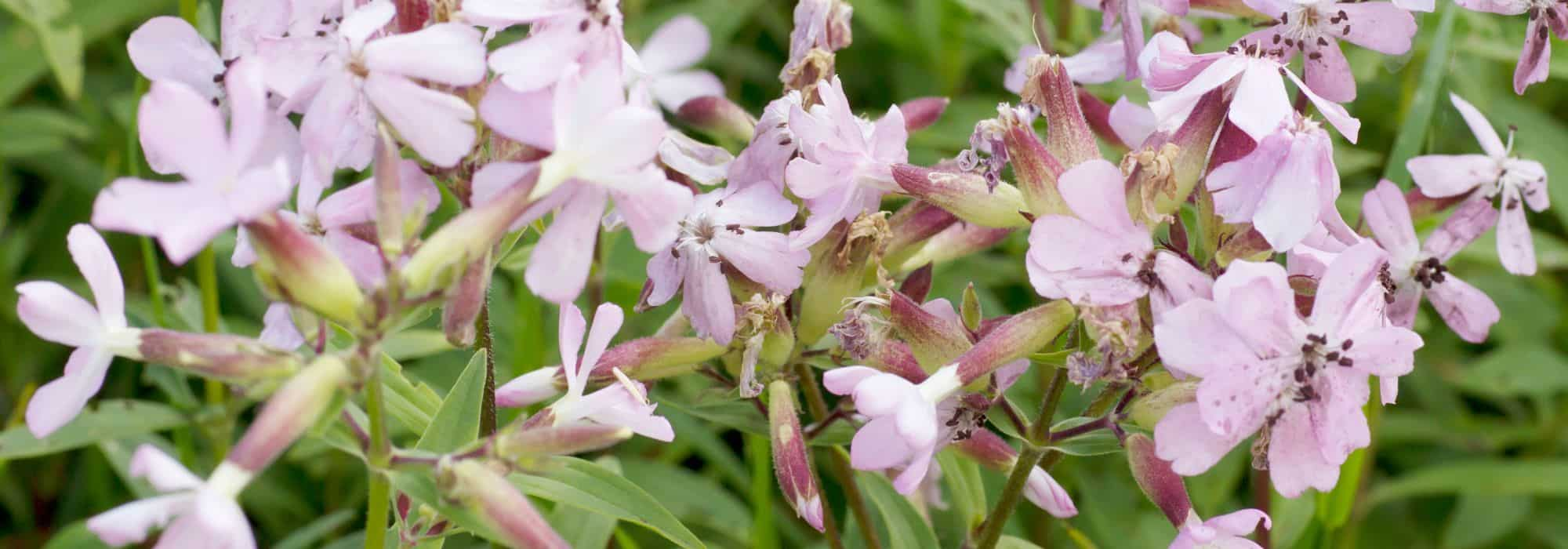
Saponaria: Planting, Growing and Caring
Contents
The soapwort in a few words
- Known as the “soapwort” or “soap herb”, Saponaria is a herbaceous perennial plant found in the wild on embankments, along paths or watercourses, in ditches, wastelands, and woodland edges.
- The genus Saponaria includes around twenty perennial and annual species with small flowers grouped in cymes.
- The flowering of soapworts ranges in various shades of pink and white from June-July to September.
- Soapwort is a spreading plant that makes an excellent, very vigorous and robust ground cover.
- Easy to grow, it requires no maintenance and adds a rustic charm to any garden.
The word from our expert
If you were lucky enough to roam the countryside as a child, you surely remember this herbaceous plant whose crumpled leaves would lather with a bit of water. This herbaceous plant is called soapwort (Saponaria officinalis) and grows almost everywhere in the wild, along paths or rivers, in fallow land, on slopes and in ditches… This lathering property is due to saponin, a natural component used in certain cleaning products.
The genus Saponaria includes around twenty species of perennial or annual plants with deciduous foliage, characterised by small five-petalled flowers, gathered in loose cymes. This very abundant flowering spreads from June to September, never fading, in various shades of pink, ranging to red, and white. This flowering adds a rustic, slightly old-fashioned charm to flower beds, rockeries, and slopes.
While Saponaria officinalis displays an upright habit and forms a lush clump, other species like Saponaria ocymoides make excellent ground covers thanks to their spreading habit. Throughout the summer, this soapwort forms a dense cushion covered with a cloud of floral clusters, perfect for filling rockeries, slopes, and the gaps in walls and paving.
Equipped with underground stolons, soapwort develops easily, requiring no special maintenance. Particularly hardy, it proves robust, vigorous, and sometimes even slightly invasive.
Beyond its softening, whitening, and degreasing properties for laundry from its leaves, soapwort also holds medicinal virtues that interest modern pharmacology.
botany
Botanical data
- Latin name Saponaria
- Family Caryophyllaceae
- Common name Soapwort, Bouncing Bet, Fuller's Herb, Hedge Pink
- Flowering From June to September
- Height 5 to 80 cm
- Exposure Partial shade or sun
- Soil type Dry or moist depending on the variety
- Hardiness Beyond -20°C
Soapwort (Saponaria) is a genus of perennial or annual plants with deciduous foliage, a member of the Caryophyllaceae family, which also includes pinks (Dianthus), baby’s breath (Gypsophila), and Lychnis. Native to the meadows and mountainous regions of southern Europe and western Asia, soapwort grows naturally in ditches, along riverbanks, on roadside embankments, field edges, and wastelands. It is highly vigorous and quickly colonises the area thanks to its running rootstocks.
Saponaria derives from the medieval Latin “Sapo-ponis,” meaning “soap.” Indeed, soapwort has been known since antiquity for its cleansing properties. Hippocrates even recommended using soapwort as a laundry detergent. The rootstocks, and to a lesser extent, the leaves and flowers of this herbaceous plant contain saponin, a natural surfactant that gives it foaming, degreasing, and cleansing properties. Laundresses used it to whiten clothes by simply infusing the roots in boiling water. This unique feature is why soapwort is also called “soap plant,” “fuller’s herb,” “hedge pink,” or “bouncing bet.”
But soapwort is also known for its medicinal properties: it was used in leprosariums to clean wounds. This plant is effective in relieving skin conditions and clearing respiratory passages as an expectorant.
The genus Saponaria includes around twenty species, some of which are very easy to grow and particularly beautiful for adding a rustic and bucolic touch to a flower bed, border, rockery, or embankment. Saponaria officinalis is the species that grows wild in our countryside. It produces underground stolons that allow it to spread rapidly. It prefers partially shaded or shaded locations, such as along the edges of woody plant beds. Its pale pink flowers take centre stage throughout the summer. A few cultivars and horticultural varieties expand the colour palette, including the white-flowered ‘Alba Plena’.
Among the perennial species, there is also Saponaria ocymoides, the rock soapwort, which forms densely flowered cushions, perfect for covering rockeries, embankments, gaps in walls, or even paving. It can also be grown in pots or planters on balconies and terraces. It comes in a lovely range of pink shades.
Like rock soapwort, Saponaria caespitosa and Saponaria pumilio are dwarf, mat-forming varieties that create dense tufts of foliage. Saponaria x olivana, a cross between the two, is highly sought after for its ground-covering ability in rockeries, thanks to its beautiful small pink flowers with a purple throat. As for Saponaria x lembergii, it is a very floriferous and spreading hybrid, a cross between Saponaria officinalis and Saponaria ocymoides. Saponaria calabrica, native to Calabria, is grown as an annual in our regions.
Depending on the species and variety, soapwort can form an upright, bushy clump 60 to 80 cm tall or a dense mat 5 to 20 cm high, spreading 40 to 60 cm wide.
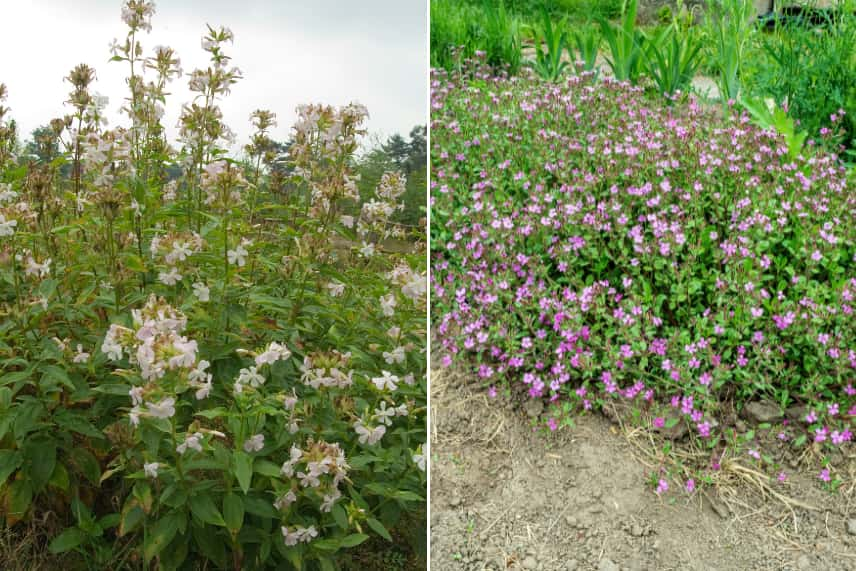
The upright common soapwort and the spreading rock soapwort
Soapwort has opposite, ovate or lanceolate, pointed leaves. They feel rough to the touch and display a bright green colour. They are deciduous along the stems—upright and sturdy for Saponaria officinalis, prostrate and spreading for Saponaria ocymoides, slightly hairy, and also disappearing in winter. However, the leaves of the rosette are more persistent.
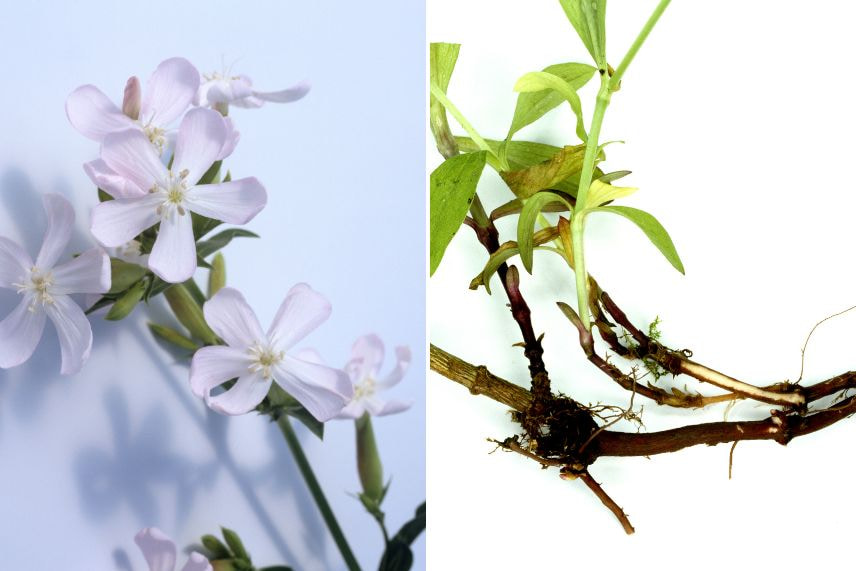
Flowers and roots of Saponaria caespitosa, a mat-forming soapwort
From early summer until September, depending on the region, soapwort produces inflorescences grouped in compact terminal cymes at the leaf axils. The short-petioled flowers consist of five unevenly spaced petals. The flowers of the common soapwort emit a clove-like scent, detectable only in the evening at sunset. The flowers of other varieties are scentless. The flowers give way to ovoid or oblong capsules containing the seeds.
Hardy well beyond -20°C, soapwort is a very easy plant to grow. Though unassuming, it is nonetheless charming, especially when planted in groups of several plants.
Read also
6 groundcover campanulasSome interesting soapwort varieties
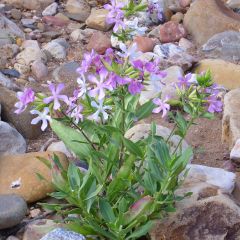
Saponaria officinalis
- Flowering time July to October
- Height at maturity 60 cm

Saponaria ocymoides
- Flowering time June to August
- Height at maturity 15 cm

Saponaria officinalis Alba Plena
- Flowering time July to October
- Height at maturity 60 cm

Saponaria officinalis Rosea Plena
- Flowering time July to October
- Height at maturity 60 cm
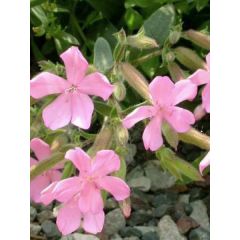
Saponaire 'Max Frei'
- Flowering time July to October
- Height at maturity 30 cm
Discover other Saponaria - Soapwort
View all →Available in 1 sizes
Available in 1 sizes
Available in 4 sizes
Available in 1 sizes
Available in 1 sizes
Available in 1 sizes
Available in 1 sizes
Available in 1 sizes
Available in 1 sizes
How, when and where to plant soapwort?
Depending on the species of soapwort, the planting conditions vary slightly.
Where to plant it?
Generally, soapwort thrives in sunny locations. In the south of France, partial shade will suit it better. However, full shade will completely halt its flowering.
In terms of soil, the various species of soapwort have slightly different needs. Indeed, the common soapwort (Saponaria officinalis), which grows naturally along our paths, prefers humus-bearing, fairly fresh, light, and moderately fertile soils that must be perfectly drained. The more compact species with a spreading habit prefer poor, even calcareous soils, rather dry in summer, and not too rich. But this soil must also be very well-drained. This is why these species are perfect for rockeries, slopes, and sunny walls. You can even grow these species in pots or large containers on a balcony or terrace.
When to plant it?
As soapwort is a perennial plant, it is planted in spring, in March or April, or in autumn, in September or October. For spring planting, you will need to ensure regular watering during the summer.
How to plant it?
Soapworts are planted in groups of 3 to 4 plants per square metre.
- Work the soil to loosen it deeply
- Remove weeds and stones
- Add some organic amendments to heavy, clayey soils, or a bit of compost or manure to poor soils for common soapwort. Ground-covering soapwort species need nothing
- Soak the soapwort root ball in a basin of water
- Dig holes twice as large as the root ball, spaced at least 30 to 40 cm apart
- Place the soapworts and fill the holes with the excavated soil
- Water generously and mulch.
Montpellier soapworts (Saponaria ocymoides) can be planted in pots, with drainage holes and clay pebbles, in a light substrate, such as special Mediterranean plant compost.
How to pair soapwort?
The different varieties of soapwort will thrive in the large beds of cottage-style gardens, where their wildflower-like appearance will make a stunning impact, especially when planted in groups of several young plants. Their wild charm allows them to pair beautifully with robust perennials such as artemisias, cornflowers, coneflowers, bee balms, sea hollies, spike speedwells (Veronica spicata), and phlox paniculata, whose flowers are very similar… You can also add a touch of lightness with ornamental grasses like fountain grasses with their feathery spikes or a Calamagrostis acutiflora ‘Karl Foerster’.
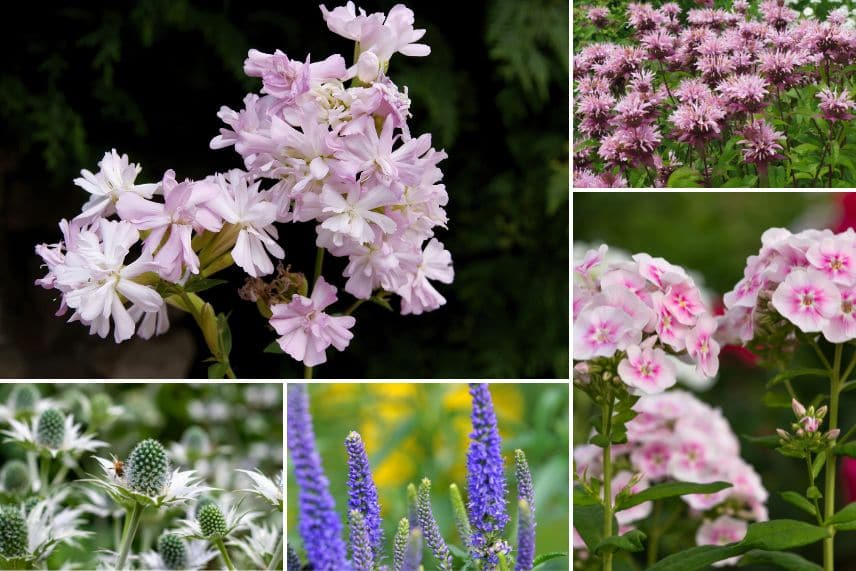
Around the soapwort, bee balms, sea hollies, spike speedwells, and phlox paniculata
On the other hand, the varieties of Montpellier soapwort, planted on walls, slopes, or sunny rockeries, will thrive alongside sedums, houseleeks, or catchflies. They can also be planted at the base of roses or with snow-in-summer (Cerastium tomentosum) at the feet of shrubs and tall perennials.
The care of soapwort
Soapwort is a very easy-to-grow perennial that requires minimal maintenance. During the first summer, watering should be fairly regular (once a week), especially for common soapwort to keep the soil moist. After that, watering can be spaced out once the soapwort is established. It should manage on its own, except during extreme heat or drought.
To enhance flowering and encourage the growth of new flowers, don’t hesitate to remove the faded blooms of common soapwort.
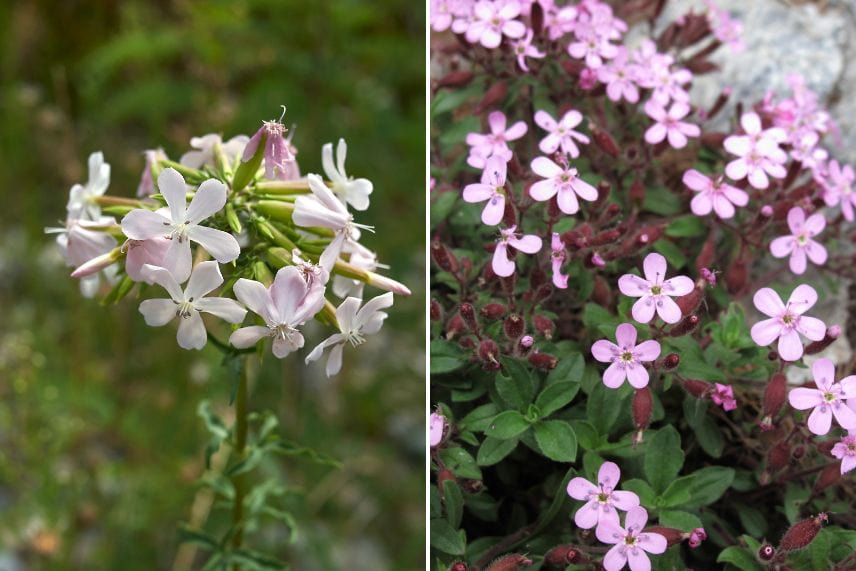
Flowers of common soapwort and Montpellier soapwort
At the very end of the flowering period, cut the plant back to ground level to prevent self-sowing and potential invasion. In winter, the deciduous foliage of soapwort almost completely disappears, only to re-emerge in March-April.
Diseases and Pests of Soapwort
No known diseases or pests affect soapwort, which demonstrates excellent resistance. Only slugs and snails may target the young shoots in spring. Ingrid shares 7 effective and natural ways to combat slugs and snails.
The propagation of soapwort
Soapwort can be propagated by dividing clumps or by sowing seeds. Division should be done every 3 years, preferably in early spring. Sowing is also done in spring (April-May), or possibly at the very beginning of autumn, in August-September.
Dividing clumps
- Dig up the clump with a garden fork
- Divide the clump by hand, separating it into several pieces, each with rootstocks and shoots
- Replant immediately
When dividing, don’t hesitate to take a few roots to make a completely natural homemade detergent. Simply wash the roots thoroughly to remove the soil. Then soak 70g of roots in a litre of water overnight. In the morning, boil for 15 minutes and strain. This detergent can be stored for two weeks.
Sowing seeds
Sowing directly in the ground is done in April or May, once the soil temperature has reached 15°C.
- Work the soil well to loosen it
- Rake to remove weed residues and stones
- Flatten the soil with the back of the rake
- Sow the soapwort seeds by scattering them
- Cover with a very thin layer of compost
- Water lightly with a fine spray
Keep the soil moist by watering lightly with a fine spray until germination. Then, it’s time to thin out, leaving only one seedling every 30 to 40 cm. When the soapwort plants reach 15 cm, pinch them to encourage branching.
- Subscribe!
- Contents




































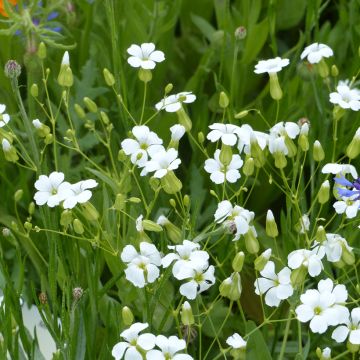
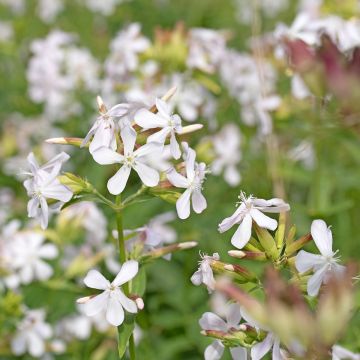
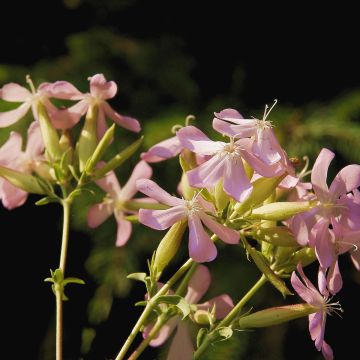


Comments